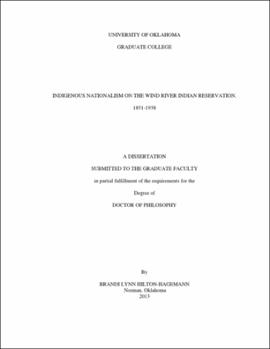| dc.contributor.advisor | Metcalf, Warren | |
| dc.creator | Hilton-Hagemann, Brandi Lynn | |
| dc.date.accessioned | 2019-05-01T17:25:55Z | |
| dc.date.available | 2019-05-01T17:25:55Z | |
| dc.date.issued | 2013 | |
| dc.identifier | 99153472002042 | |
| dc.identifier.uri | https://hdl.handle.net/11244/319524 | |
| dc.description.abstract | This dissertation seeks to alter the ways in which scholars address indigenous group formation. Instead of adhering to the rather pervasive, and anthropologically based, band/tribe/nation approach, this work argues that historians should address indigenous peoples as "tribal nations," a phrase that reflects both their unique place within the United States as "nations within" and their sovereign status. To do so, I have created a loose set of six characteristics that all tribal nations exhibit including territory, citizens/members, political authority, language, cultural representations and a shared history. Each chapter in this dissertation addresses one of these traits. Additionally, this work argues that to study indigenous peoples in isolation, or give primacy to indigenous reactions to non-Native actions, tends to give the impression that Native peoples are static, unwilling or unable to adapt and change. Therefore, the second part of the tribal nation model includes four forces of influence (internal demand, other tribal nations, the federal government and non-Native outsiders) who certainly promoted change, both good and bad, throughout the history of the tribal nation, but I give primacy, when possible to Native-Native interactions. | |
| dc.description.abstract | Together, the six characteristics and four forces of change provide a model that can be applied to almost any tribal nation. This process of analysis allows scholars to better study indigenous people and create meaningful "tribal histories" that place Native people at the center of the narrative and underscore their resilience. To demonstrate the utility of this model, I have chosen to study the Northern Arapaho and Eastern Shoshone because of their unique position as two distinct tribal nations who live on the same reservation, yet are so very different. In the end, this dissertation demonstrates the efficacy of the tribal nation model and encourages scholars to reassess the ways in which they discuss indigenous peoples and their histories. | |
| dc.format.extent | 343 pages | |
| dc.format.medium | application.pdf | |
| dc.language | en_US | |
| dc.relation.requires | Adobe Acrobat Reader | |
| dc.subject | Indians of North America--Ethnic identity | |
| dc.subject | Indians of North America--Social life and customs | |
| dc.subject | Indians of North America--History | |
| dc.subject | Shoshone Tribe of the Wind River Reservation, Wyoming | |
| dc.subject | Northern Arapaho Tribe | |
| dc.subject | Wind River Indian Reservation (Wyo.) | |
| dc.title | Indigenous Nationalism on the Wind River Indian Reservation, 1851-1938 | |
| dc.type | text | |
| dc.type | document | |
| dc.thesis.degree | Ph.D. | |
| ou.group | College of Arts and Sciences::Department of History | |
